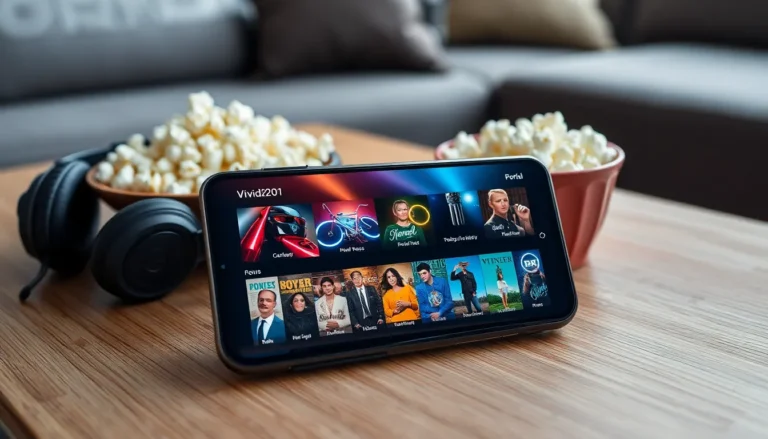Imagine a world where your toaster and fridge can negotiate breakfast deals while your car finds the fastest route to avoid traffic—all without human intervention. Welcome to the dazzling realm of blockchain and the Internet of Things (IoT). This tech duo is revolutionizing how devices communicate, making them smarter, safer, and a whole lot more entertaining.
Table of Contents
ToggleOverview of Blockchain Internet of Things
Blockchain Internet of Things (IoT) combines decentralized network capabilities with smart, connected devices. This fusion enhances security, transparency, and efficiency in device interactions. Using blockchain, devices can securely record and share data without needing a central authority.
Devices operate autonomously by leveraging smart contracts. Smart contracts enable machines to execute transactions based on predetermined conditions. An example includes a smart thermostat negotiating energy prices with a utility service, ensuring optimal energy use and cost savings.
Enhanced security is a significant advantage of this integration. With traditional IoT, vulnerabilities can lead to data breaches. Blockchain technology mitigates these risks through cryptography and immutable ledgers, making unauthorized access nearly impossible.
Interoperability becomes easier as diverse devices connect seamlessly. Various manufacturers can utilize blockchain technology to create standardized communication protocols. This ensures devices from different brands can interact efficiently.
Data provenance plays a critical role in this ecosystem. Each device can trace the origin of the data shared, ensuring authenticity and trustworthiness. For instance, a supply chain IoT device can record every step in the delivery process using blockchain, creating an unchangeable record of events and enhancing accountability.
Scalability presents both opportunities and challenges. As more devices connect, managing data flow and transaction speeds can become complex. However, advancements in blockchain technology aim to address these issues, ensuring that network scalability meets future demands.
The future of Blockchain IoT holds immense potential for various sectors, from smart homes to industrial applications. Leveraging this technology can lead to improved efficiencies, security, and innovation across industries.
Benefits of Blockchain Internet of Things

The integration of blockchain with the Internet of Things offers numerous advantages. Enhanced security and improved data integrity stand out as key benefits for connected devices.
Enhanced Security
Enhanced security strengthens the protection of IoT devices through blockchain technology. Cryptography secures communication between devices, reducing vulnerability to unauthorized access. An immutable ledger ensures that data remains tamper-proof, which builds trust in the system. Each device can verify data authenticity, lowering the risk of data breaches, and creating a safer digital environment. Manufacturers can implement secure firmware updates, further fortifying the system against potential cyber threats. Overall, this robust security framework helps organizations protect sensitive information and maintain operational continuity effectively.
Improved Data Integrity
Improved data integrity ensures the accuracy and authenticity of information shared among devices. By maintaining an unchangeable record of transactions, blockchain allows for precise tracking of data. Each transaction is time-stamped and linked, making it easy to identify sources and anomalies. Devices can access reliable data, which supports better decision-making in various applications, such as supply chain management. Consequently, businesses benefit from enhanced transparency and accountability, boosting consumer confidence. In sectors where data accuracy is crucial, this trust enhances operational efficiency and strengthens partnerships.
Applications of Blockchain Internet of Things
Blockchain IoT offers diverse applications transforming industries through enhanced connectivity and security. Two key domains include smart transportation and smart agriculture.
Smart Transportation
Smart transportation utilizes blockchain to enhance the efficiency and safety of travel. Vehicles equipped with IoT devices can share real-time data regarding traffic conditions and road hazards. With blockchain’s secure records, shared data becomes immutable, preventing tampering. Fleet management benefits from this technology as companies can track vehicle locations and maintenance needs more efficiently. Blockchain also facilitates autonomous car operations, enabling vehicles to communicate with each other and negotiate safe passage. Additionally, smart contracts can automate toll payments, streamlining processes for drivers and allowing for accurate billing.
Smart Agriculture
Blockchain IoT significantly impacts agriculture by improving transparency and traceability in food supply chains. Farmers equipped with smart sensors can monitor soil health and crop conditions, sending real-time data to a blockchain for secure storage. This immutable record allows consumers to trace food origins, increasing trust in food safety. Additionally, smart contracts can manage transactions between farmers and retailers effectively, automating payments based on delivery conditions. Equipment and machinery can also be monitored for maintenance needs, reducing downtime and optimizing resource use. Overall, these advancements foster sustainable farming practices and enhance productivity.
Challenges Facing Blockchain Internet of Things
Several challenges impact the integration of blockchain technology with the Internet of Things. Addressing these issues is crucial for maximizing the benefits of Blockchain IoT.
Scalability Issues
Scalability presents a significant challenge as the number of connected devices grows. Many blockchain networks struggle to handle large volumes of transactions efficiently. Increased device interactions result in higher data traffic, potentially leading to slow processing times and network congestion. Solutions like sharding and layer-two protocols can improve throughput, enabling faster transactions. Adopting these innovations ensures the network can scale without compromising performance.
Interoperability Concerns
Interoperability concerns arise from diverse IoT devices and varying standards. Many devices lack seamless communication capabilities, leading to integration issues. Manufacturers often develop proprietary systems that hinder collaboration. Implementing standardized protocols could facilitate better connectivity among devices, fostering collaboration across different networks. As a result, achieving interoperability allows Blockchain IoT to realize its full potential and drive widespread adoption.
Future of Blockchain Internet of Things
The future of Blockchain Internet of Things (IoT) presents vast opportunities across multiple sectors. Enhanced efficiencies emerge as interconnected devices begin to utilize blockchain for secure data exchanges. Increased security from cryptographic techniques bolsters trust in these device interactions.
Scalability presents a significant challenge, as an influx of connected devices strains current blockchain networks. Solutions such as sharding and layer-two protocols can mitigate this issue, improving transaction speed without sacrificing performance. Enhanced interoperability plays a vital role; diverse IoT devices must communicate seamlessly across different standards. Standardizing communication protocols is essential for overcoming these barriers.
Autonomous operations will redefine how devices interact with each other. Smart contracts enable devices to execute transactions autonomously, optimizing processes in real-time. Examples include smart thermostats negotiating energy prices dynamically, maximizing efficiency and cost-effectiveness.
Several industries show promise in adopting this technology. Smart transportation, for instance, can leverage real-time data sharing to enhance travel safety. Vehicles equipped with IoT devices can report traffic conditions, assisting fleet management with better decision-making. In smart agriculture, farmers can utilize sensors to monitor crop health, securely storing this information on a blockchain. Immutable records promote transparency, allowing consumers to trust the authenticity of food products.
Flexibility across various applications fosters innovation. Industries that embrace Blockchain IoT not only improve operational efficiencies but also enhance customer experiences. Future advancements in technology will continue to refine these applications, paving the way for a connected world that prioritizes security and transparency.
The integration of blockchain technology with the Internet of Things promises to revolutionize how devices interact and operate. Enhanced security and improved data integrity are just the beginning of what this synergy can achieve. As smart devices become more autonomous and capable of negotiating transactions, industries will see significant advancements in efficiency and transparency.
While challenges like scalability and interoperability remain, ongoing innovations in blockchain are paving the way for solutions. The potential applications in sectors like transportation and agriculture highlight the transformative impact of Blockchain IoT. Embracing this technology could lead to smarter cities and more sustainable practices, ultimately reshaping the future of connectivity and automation.


